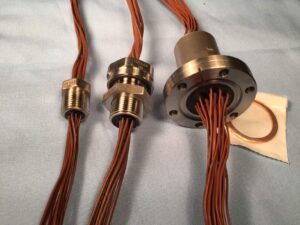Engineers who deal with high-voltage electrical switches, medical-imaging systems, space-simulation vacuum chambers, and military-ordinance control applications know too well the indispensable use of vacuum feedthrough connectors. For these types of equipment to work perfectly, engineers must maintain a vacuum environment at all times. Matter and energy must pass from the outside of a vacuum chamber to the inside, without any leakages. A vacuum feedthrough connector comes in handy for this purpose. Vacuum feedthrough may also be referred to as electrical feedthrough, hermetic feedthrough, epoxy feedthrough, glass feedthrough, and ceramic feedthrough.
Here are the benefits of utilizing a high-quality vacuum feedthrough connector.
1. Boosts the Performance of Vacuum Chambers
For the industrial machines that utilize vacuum chambers to function optimally, a vacuum feedthrough connector must perform its two primary functions:
- Deliver energy in the form of electricity or light pulse inside the vacuum chamber
- Feed the vacuum chambers with liquids and gases to facilitate operations
Industries such as aerospace that need massive vacuum chambers require the best quality of vacuum feedthrough connectors. Engineers in these industries prefer hermetic electrical feedthroughs over the bulkhead electrical connectors because they are less prone to leakages. Most of the feedthrough connectors in the large vacuum chambers are usually permanently sealed to make them completely airtight. Given the speed of electricity – 6,696,000 miles per hour, it is much more effective to have hermetic electrical feedthrough for your vacuum chamber.
2. A Vacuum Feedthrough Connector Has No Design Constraints
Unlike bulkhead connectors that cause engineers unnecessary design constraints, electrical feedthrough are more flexible. They also utilize less space on the system, and this gives designers room to be more creative. A bulkhead connector has a limit to the gauge and number of conductors that can be used in a system. When designing large vacuum chambers, engineers would be forced to compromise their designs to accommodate multiple bulkhead electrical connectors. But using a vacuum feedthrough connector gives designers more freedom in their designs, as they can use a single-wire feedthrough. When your vacuum chamber application does not require constant disconnection of wires, you will be better of using hermetic electrical feedthroughs.
flexible. They also utilize less space on the system, and this gives designers room to be more creative. A bulkhead connector has a limit to the gauge and number of conductors that can be used in a system. When designing large vacuum chambers, engineers would be forced to compromise their designs to accommodate multiple bulkhead electrical connectors. But using a vacuum feedthrough connector gives designers more freedom in their designs, as they can use a single-wire feedthrough. When your vacuum chamber application does not require constant disconnection of wires, you will be better of using hermetic electrical feedthroughs.
3. Vacuum Feedthroughs Eliminate Electrical Problems Such As Voltage Drop and Contact Resistance
Hermetically sealed connector pass energy and matter to a vacuum chamber with no pressure loss. This reduces voltage drop, contact resistance, and other electrical problems that are common with bulkhead connectors. Some electrical feedthroughs may allow engineers to use different types of wires and conductors in the same feedthrough. Therefore, designers have space and allowance to use modern wire harnesses that solve common connector problems. Additionally, hermetic feedthroughs don’t protrude like the bulkhead connectors. As a result, they provide more space for the moving parts. Workers can also work more freely without running the risk of colliding with the protruding bulkheads.
4. An Electrical Feedthrough is more Cost-Effective
Because vacuum feedthrough connectors give designers more flexibility, they are able to come up with more affordable vacuum chamber designs. With bulkhead connectors, engineers have to design their systems around the best-fit connectors. Given that feedthroughs allow you to use more wires and conductors at a go, you will use fewer materials.
Well-designed feedthroughs have an increased connector density, meaning that a single-wire feedthrough can accommodate all the power and signal wires needed by a vacuum chamber. As a result, multiple bulkhead connectors are eliminated. Overall, the maintenance and installation costs of equipment using vacuum feedthrough connectors will be less, compared to those using multiple bulkhead connectors. Designing vacuum chambers that utilize electrical feedthrough takes engineers less time and materials. Therefore, they can design great equipment at a lower cost.
Regardless of the application or the industry that vacuum chambers are used, those with electrical feedthroughs will always perform better. A vacuum feedthrough connector will require less maintenance and still work optimally. Hermetic electrical feedthroughs boost the performance of a vacuum chamber, by ensuring that matter and energy pass through with zero leakages.